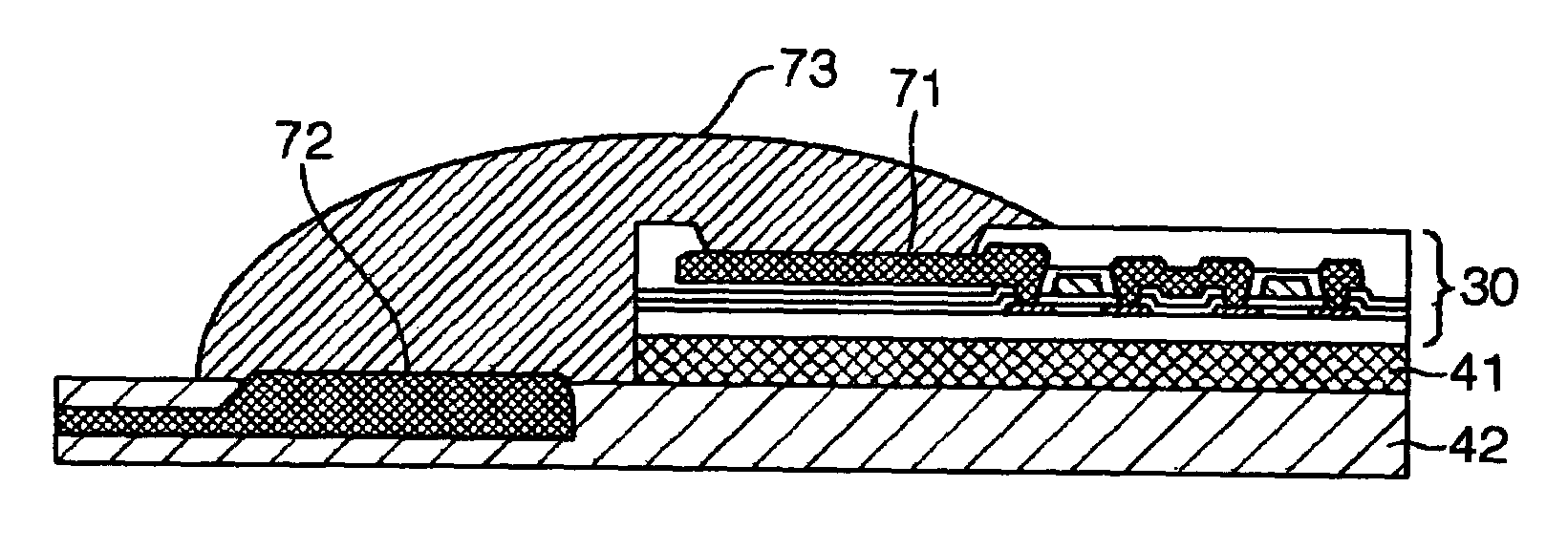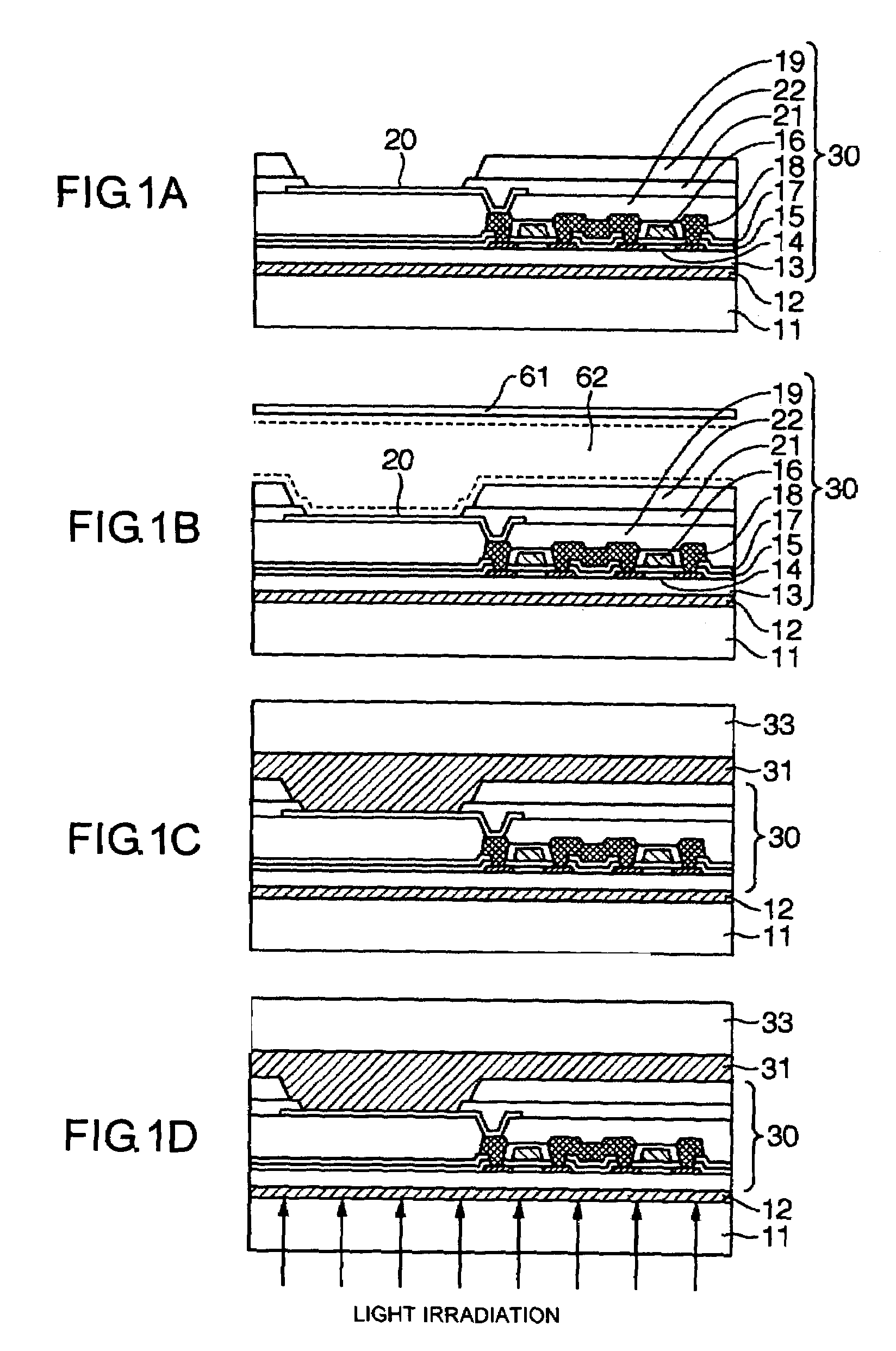Method of producing thin-film device, electro-optical device, and electronic apparatus
a thin-film device and electrooptical technology, applied in the direction of gearing details, instruments, transportation and packaging, etc., can solve the problems of inferior shape stabilities, low mechanical strength of plastic substrates, etc., and achieve low mechanical strength, low dimensional precision, and inferior shape stabilities
- Summary
- Abstract
- Description
- Claims
- Application Information
AI Technical Summary
Benefits of technology
Problems solved by technology
Method used
Image
Examples
first exemplary embodiment
[0031]An exemplary embodiment of the present invention is described below with reference to the drawings. According to the exemplary embodiment of the present invention, a functional element, such as a fine structure, a thin-film circuit, etc., is formed on a first substrate made of quartz glass, alkali glass, etc. The functional element is shifted onto a second substrate by the transfer method described above. In the formation of the functional element on the first substrate, the film-patterning is carried out by photolithography. On the other hand, film-patterning on the second substrate is not carried out by the photography. Film-patterning required after the transferring is carried out by a technique not using mask-alignment, such as a liquid-drop jetting method. Thus, it is desirable to carry out the film-patterning on only the first substrate.
[0032]For example, in the case in which the thin-film device is an organic EL display device, the process from the first step to the ste...
second exemplary embodiment
[0052]The second exemplary embodiment is described below with reference to FIGS. 4A to 5D. The elements in these drawings corresponding to those in FIGS. 1A to 1D and FIGS. 2A to 2D are represented by the same reference numerals, and their descriptions are not repeated.
[0053]According to the second exemplary embodiment, the above-described liquid-repelling treatment of the bank layer 22 (FIG. 2D) is not carried out, but the bank layer 22 itself is formed in a film-shape by use of a material having a liquid-repelling property. Thus, the bond of the bank layer 22 to the adhesive layer 31 may become insufficient. Accordingly, an intermediate layer 23 is formed between the bank layer 22 and the adhesive layer 31. A required bonding force between the bank layer 22 and the adhesive layer 31 is secured by the intermediate layer 23. The intermediate layer 23 is removed after the thin-film circuit layer 30 is transferred onto the final substrate. The light-emission area is treated so as to h...
third exemplary embodiment
[0060]The third exemplary embodiment is described below with reference to FIGS. 6A–6E. In FIGS. 6A–6E, elements equivalent to those in FIG. 2C are represented by the same reference numerals. Descriptions of the equivalent elements are not repeated.
[0061]According to the third exemplary embodiment, an organic EL display device is produced by a mask-evaporation method instead of the liquid-drop jetting method used in the first exemplary embodiment. The thin-film circuit layer 30 including a fine structure is formed on the first substrate by photolithography, and is transferred onto the second exemplary embodiment, similarly to the first exemplary embodiment.
[0062]In the case where the organic EL display is produced by the mask-evaporation method, the bank 22 described in the first exemplary embodiment is not necessary. Thus, the thin-film circuit layer 30 formed by the process of the first step to the opening in the pixel area is transferred (FIG. 6A).
[0063]Then, an organic El materia...
PUM
| Property | Measurement | Unit |
|---|---|---|
| length | aaaaa | aaaaa |
| length | aaaaa | aaaaa |
| electroconductive | aaaaa | aaaaa |
Abstract
Description
Claims
Application Information
 Login to View More
Login to View More - R&D
- Intellectual Property
- Life Sciences
- Materials
- Tech Scout
- Unparalleled Data Quality
- Higher Quality Content
- 60% Fewer Hallucinations
Browse by: Latest US Patents, China's latest patents, Technical Efficacy Thesaurus, Application Domain, Technology Topic, Popular Technical Reports.
© 2025 PatSnap. All rights reserved.Legal|Privacy policy|Modern Slavery Act Transparency Statement|Sitemap|About US| Contact US: help@patsnap.com



